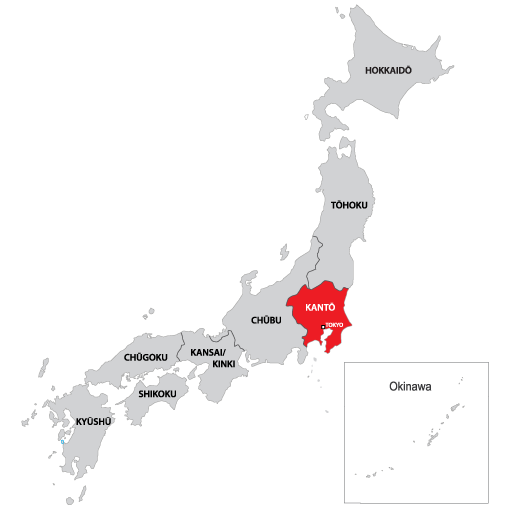

Kanto is one of the more powerful regions, due in no small part to the number of population hubs in the region, particularly Japan's modern capital since 1869, Tokyo.
The prefectures that make up the Kanto region of Japan on the main island of Honshu are home to a third of the population of Japan.
Chiba Prefecture
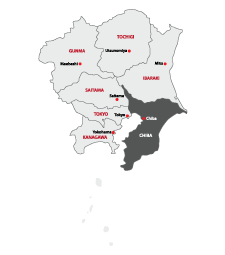 Most visitors to Japan arrive through Chiba, home of Narita town and Narita Airport. It is also home to Tokyo Disneyland and Tokyo DisneySea. The Chiba Bay area is home to these famous amusement parks and there are easy rail connections to Tokyo. DisneySea park is currently the only one of its kind in the global selection of Disney parks.
Most visitors to Japan arrive through Chiba, home of Narita town and Narita Airport. It is also home to Tokyo Disneyland and Tokyo DisneySea. The Chiba Bay area is home to these famous amusement parks and there are easy rail connections to Tokyo. DisneySea park is currently the only one of its kind in the global selection of Disney parks.
Near Narita are the Edo towns of Sawara, a merchant city, and Sakura, which retains a preserved samurai district. Shinshoji Temple sits at the end of Narita Omotesando and has had a presence here since the year 940. Naritasan Park just beyond Shinshoji offers the tranquility of wooded slopes before opening into a pond. Nearby Sawara town also retains some of its Edo features in preserved buildings and waterways. Yoro valley on the Boso peninsula is home to the Awamata no taki waterfall. Mt. Nokogiri is known for its lookouts over the Boso peninsula and for the enormous 31m Buddha statue carved into the mountain’s granite side. At its base is Nihonji Temple. In addition, there are some 500 other Buddha statues in the temple precincts. On the Boso peninsula itself, Okinoshima island, the Nojimazaki Lighthouse and Kujukuri beach offers miles of sandy coastline and surfing. Oyama Senmaida are rice terraces fed by rainwater. The Noda area is home to the globally known Kikkoman soy sauce and Yamasa, another nationally known producer is based in the Choshi area.



Ibaraki Prefecture
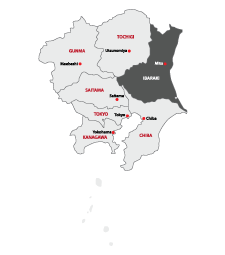 Just across the Tone river, neighbouring Ibaraki prefecture is known for the seasonal displays of flowers in Hitachi Seaside Park – a riot of colour in blue, green, or crimson, depending on the time of year. Flower lovers may also wish to visit Suigo for the Ayame Festival celebrating the mid-summer blooming of irises in Suigo Itaki Ayame Garden. Oarai Beach offers watersports and a sizable aquarium with some sharks as well as the picturesque torii of Oarai Isosaki Jinja.
Just across the Tone river, neighbouring Ibaraki prefecture is known for the seasonal displays of flowers in Hitachi Seaside Park – a riot of colour in blue, green, or crimson, depending on the time of year. Flower lovers may also wish to visit Suigo for the Ayame Festival celebrating the mid-summer blooming of irises in Suigo Itaki Ayame Garden. Oarai Beach offers watersports and a sizable aquarium with some sharks as well as the picturesque torii of Oarai Isosaki Jinja.
Mito, the capital of Ibaraki, is home to one of the three great gardens of Japan, Kairakuen, a strolling-style garden famous for its plum blossoms. The Mito clan was historically one of the powerful regional families of the Edo period. Education of the lords of the future took place in the Kodokan, where physical training and strategic training formed part of the curriculum. In northern Ibaraki prefecture, two naturally beautiful sights stand out – the wide 120m high Fukuroda waterfall, and the rugged Izura coastline.
Ibaraki is also home to the Tsukuba Space Center, Tsukuba Science City, and JAXA, the Japan Aerospace Exploration Agency. Although the area has a technological hub, it retains the natural beauty of Mt Tsukuba, which offers gentle hiking as well as a ropeway to the top. Standing protectively over the area is the 120 m high Ushiku Daibutsu, a massive statue of Buddha in standing position. Kashima Jinja is one of the oldest shrines in Eastern Japan, reputedly built by Emperor Jimmu, Japan’s first, in the 6th century. Ibaraki is also known for its sake and its summer festivals, like the Yasaka Shrine Gion Festival and the Shimodate Gion Festival in July, the Mito Komon Festival, and the August Kasama no Matsuri and Matsuri Tsukuba festivals, both of which feature large fierce-looking lanterns reminiscent of the Aomori Nebuta festival. The Ishioka no Omatsuri festival in September is also a highlight of the year.



Tochigi Prefecture
 Nikko, a UNESCO World Heritage site just 2 hours north of Tokyo, is one of the best-known highlights of Tochigi prefecture. Toshogu Shrine contains the mausoleum of Tokugawa Ieyasu, the founder of the powerful Tokugawa Shogunate that united the warring states of Japan. The shrine is known for its ornate colourfully decorated carvings. Older still at Nikko are Futarasan Shrine and Rinnoji Temple, both sacred sites founded in the 8th century in dedication to the 3 mountains of Nikko.
Nikko, a UNESCO World Heritage site just 2 hours north of Tokyo, is one of the best-known highlights of Tochigi prefecture. Toshogu Shrine contains the mausoleum of Tokugawa Ieyasu, the founder of the powerful Tokugawa Shogunate that united the warring states of Japan. The shrine is known for its ornate colourfully decorated carvings. Older still at Nikko are Futarasan Shrine and Rinnoji Temple, both sacred sites founded in the 8th century in dedication to the 3 mountains of Nikko.
The Nikko area is also known for its hiking in the Oku Nikko or Nikko Yumoto areas as well as the marshland walking of the Senjogahara area. Lake Chuzenji and the Kegon-no-taki falls exemplify the natural beauty that inspired the creation of these sacred sites. To the east of Nikko lies the Kinugawa Kawaji Onsen or hot springs. Before a soak, enjoy a trip down the Kinugawa river in traditional wooden boats The Edo Wonderland museum in this area provides a uniquely Japanese theme park experience, where visitors can feel like they have been transported back to the Edo period as performers and interpreters living as in Edo. The Mashiko area of Tochigi is famed for its pottery and while it is a small town, it has a global reputation amongst potters and craftspeople worldwide. Mashiko attracts fans of folk artist Shoji Hamada who come to see his stepped or climbing kilns. In the north of the prefecture, the Nasu Shiobara Highlands and Mt Nasudake, an active volcano, offer hiking and hot springs. Ashikaga flower park is a draw year-round, and even over the winter with its illuminations instead of flowers, it shines in May when trailing wisteria is in bloom.



Tokyo Prefecture
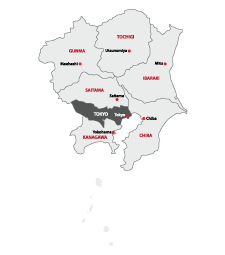 Kanto is one of the more powerful regions, due in no small part to the number of population hubs in the region, particularly Japan’s modern capital since 1869, Tokyo. Tokyo is known for its size, diversity of experience, and sophistication. For many visitors to Japan, after landing at Narita or Haneda, Tokyo is their entry point and first experience of Japan. Various polls name Tokyo the ‘most expensive’, ‘most liveable’, the ‘safest’ global city and it continues to rank high on lists of top urban destinations. The city has hosted global events such as the Olympics, and G-7 summits. In the summer of 2020, the city hosts the Olympics and Paralympics. The city dominates the country and overshadows many other international capitals with its population of over 14 million people. Approximately 11% of the entire population of Japan lives in Tokyo Prefecture.
Kanto is one of the more powerful regions, due in no small part to the number of population hubs in the region, particularly Japan’s modern capital since 1869, Tokyo. Tokyo is known for its size, diversity of experience, and sophistication. For many visitors to Japan, after landing at Narita or Haneda, Tokyo is their entry point and first experience of Japan. Various polls name Tokyo the ‘most expensive’, ‘most liveable’, the ‘safest’ global city and it continues to rank high on lists of top urban destinations. The city has hosted global events such as the Olympics, and G-7 summits. In the summer of 2020, the city hosts the Olympics and Paralympics. The city dominates the country and overshadows many other international capitals with its population of over 14 million people. Approximately 11% of the entire population of Japan lives in Tokyo Prefecture.
It is hardly surprising then that the image that springs to mind when one mentions Japan is the glass and steel, neon, and signboard flicker of Tokyo and its densely packed lively areas of Shibuya or Shinjuku. Any visitor to Tokyo will tell you that the city, like the nation itself, is incredibly diverse and that the uber modernity sits side by side with tradition and history. Tokyo prefecture extends through a total of 23 special wards which form the capital as well as 26 smaller commuter cities to the west, 5 towns, and 8 villages and includes rural countryside and ocean islands like Mt. Takao, the Mitake area, and the remote Ogasawara Islands.
For those whose visit only extends to Tokyo, Mt Mitake, located in the Chichibu-Tama-Kai National Park, offers accessible hiking, a stunning rock garden, and the ancient Musashi Mitake Shrine. Mt Takao also offers hiking outside the city and has a monkey park where you can view Japanese macaques in their natural environment, and Yakuo-in, a temple associated with both Shugendo and tengu. Rural Tokyo also extends to the Izu Islands, as well as the very much more distant subtropical Ogasawara Islands. Izu islands Niijima and Hachiojima are known for snorkeling, diving, and surfing. The most remote of the Izu Islands, Aogashima, is a volcanic island over 350km from Tokyo. Most of the islands can be accessed by ferry or air. Many of the Izu Islands are within reasonable proximity to Tokyo, but the Ogasawara Islands require time and planning to visit. The 24-hour ferry to the islands operates weekly! For those who come, this UNESCO World Heritage site offers dramatic landscapes and unique bird-watching opportunities.
The city itself started as Edo, a sleepy fishing village in Musashi province. In 1603, Tokugawa Ieyasu, responsible for uniting Japan’s kingdoms into a nation, made Edo his base. Thus, Tokyo’s historical importance in Japan pre-dates its establishment as the national capital. While the city has taken on the name of Tokyo, meaning ‘eastern capital’, longstanding Tokyoites refer to themselves as ‘Edokko’ or children of Edo. The Great Kanto Earthquake, and the firebombing of World War II have removed the most visible traces of historic Tokyo and the modern architecture prevails. For many, it is the 23 special wards that make up the urban capital of Tokyo that are their vision of the city. The city is centered around the three wards of Chiyoda, Chuo, and Minato, and here you will find the Imperial Palace, the National Government precincts, and Tokyo Station, as well as the headquarters of many global Japanese companies and conglomerates. Because the extensive Imperial Palace and its grounds sit in the center of Tokyo, there is no urban ‘center’, and Tokyo is characterized by several smaller areas and districts that each have a unique character. These districts are better known than the wards that contain them.
Within the most central areas of Tokyo, you will also find Nihonbashi – the bridge that is mile zero in Japan and a historic starting point for 5 major roads that stretch throughout Japan. Ginza has become a byword for high fashion and classically stylish Tokyo and many international brands and local Japanese brands with global reach are found here. The area takes its name from a mint that existed here in the Edo period, and today you’ll find the Kabukiza Kabuki theater and numerous prestigious art galleries.
In Ginza and Nihonbashi you’ll find Tokyo’s most prestigious department stores and smaller specialized shops with centuries of history. The Marunouchi district near Tokyo Station is home to some of the largest Japanese banks and financial organizations. Japan’s political establishment and government buildings sit in the Nagatacho area.
Tsukiji, once home to the Central Metropolitan Market, still retains the old outer Tsukiji Market shops selling traditional Japanese foodstuffs and knives. The Kanda and Jimbocho neighbourhoods, sitting between Meiji University and the University of Tokyo are home to the Kanda Myojin shrine and the booksellers’ districts.



The former geisha district of Kagurazaka has a chic atmosphere with inviting small lanes. Akihabara has become a mecca for popular culture lovers and fans of Japanese video games, anime, manga, and electronics. Tokyo Dome entertains sports and music lovers, as well as thrill-seekers at the city center amusement park complete with roller-coaster and Ferris wheel. Those seeking more tranquil pursuits will find the Koishikawa Korakuen Gardens and the Spa LaQua complex. The modern Tokyo tower and the traditional Hama Rikyu Garden lie close to the Hamamatsucho district.
Northern Tokyo combines a mix of modern Tokyo and some of the city’s older shitamachi feel of the’ lower city’. Ikebukuro is a lively district that is the gateway rail station for several westbound lines. Being firmly on the commuter belt, the area is home to modern attractions like Sunshine City, which is itself an entertainment destination, and the Tobu and Seibu department stores as well as many numerous shops and stores east of the station. The streets of Western Ikebukuro play host to evening entertainments such as karaoke bars, izakaya, and restaurants.
Beyond Ikebukuro is the district of Nakano, and the Nakano Broadway shopping complex with many shops catering to those with an interest in pop culture collectibles as well as manga and anime, as well as to cosplayers. The nearby Sugamo district and its shopping street have all the buzz of Harajuku, but with an older demographic of aunties and grannies. Yanaka, Nippori, and Nezu are all older districts of Tokyo.
Nippori is a great destination for those seeking to purchase Japanese fabrics. Neighboring Yanaka has a retro feel, particularly along the Yanaka Ginza where you find pickle, tofu, and croquette sellers. It’s easy to spend a morning or afternoon wandering through this district to make your own discoveries. Yanaka cemetery is the final resting place of artists, authors, and warlords. Nezu Shrine attracts flower lovers every spring for the Azaleas that dress the grounds in a riot of color. Here you’ll still find the rare pre-war wooden building.
In Ueno Park, visitors will find the Tokyo Zoo, which draws many visitors to see the Panda. Within the park are smaller shrines, temples, and commemorative statues. Ringing the park are several museums exploring the arts and science. The king of these is the Tokyo National Museum. Its permanent collection provides a comprehensive overview of Japanese art, craft, design, sculpture, textile production, and calligraphy. Special exhibitions focusing on specific themes cycle throughout the year. Near Ueno Station, Ameyoko Market includes vendors of all descriptions – fruit sellers, fish and crab sellers, snack sellers, accessory vendors, and fashion stalls.
Eastern Tokyo is home to Asakusa, one of Tokyo’s most popular districts. Senso-ji temple attracts millions of visitors a year, and its majestic gates with enormous paper lanterns marking the route to the temple are a standout sight. The approach to the temple, Nakamise Dori, is lined with rows of small shops marketing to visitors for many years and include producers of snacks, traditional sweets such as dango, and ningyo yaki, as well as more modern souvenirs to appeal to all tastes. At Sensoji you can purchase a fortune written in English. The side streets of Asakusa reveal lively eateries and theaters, tempura restaurants, as well as Kappabashi Dori – famous for offering everything you would need to open a restaurant – including fake food models for display in the windows.
Across the Sumida River, you’ll see one of Tokyo’s newer attractions rising into the sky. Tokyo Skytree provides views over the city from two different observatories. Within the Tokyo Skytree complex are a wide array of shops and restaurants, with something to appeal to everyone, including fans of Pokemon, Hello Kitty, Ultraman, and Studio Ghibli.
Nearby Ryogoku is sumo central for Tokyo. The Kokugigan plays host to the Tokyo sumo bassho held during the year and the surrounding streets contain sumo beya and chanko nabe restaurants. The Edo Tokyo Museum is also located in Ryogoku and provides a good overview of the city’s history in a hands-on fashion that appeals to visitors of all ages.
Toyosu is the new home of the Central Metropolitan Wholesale Market and many vendors and restaurants that used to be located in the inner Tsukiji market have relocated here. The Toyosu area is also home to the TeamLab Planets digital art exhibition.



Southern Tokyo offers a variety of experiences and districts. Odaiba is a man-made area of land in Tokyo surrounded by water. It is a destination for shopping and more specialist museums and entertainments like Fuji TV studios, the Miraikan Science Museum, and the Oedo Onsen Monogatari hot springs complex, as well as one of the TeamLab digital art exhibitions. Shinagawa is a transport hub and home to smaller art museums.
Roppongi has emerged as an art destination on the back of the Roppongi Art Triangle, and other cultural sites found in the multi-use complexes of Roppongi Hills and Tokyo Midtown. The area is also known for its nightlife – sometimes refined, sometimes wild. Adjacent Akasaka has a more upscale and refined vibe and is home to television studios and many company headquarters.
Trendy Ebisu is home to the Yebisu brewery where you can learn about the brewing process and sample a glass. You’ll also find upmarket shopping complexes, the Photography Museum, a Noh theater, and smaller art museums in the district. Naka-Meguro also is quite a trendy and sophisticated area of Tokyo in the area lining a picturesque river. International and Japanese restaurants, small boutiques make it a popular area among the fashionable set. During cherry blossom season, visitors flock here to see the blooms in full glory and the river of petals drifting on the water.
The districts of Western Tokyo are vibrant and lively. Shibuya has become the image of the pulsing city, with its ‘scramble’ crossing outside the station. It is an area that constantly reinvents itself and which is continuing to change and evolve. Not only is the fashion of the Shibuya area on-trend, but it also sets the trend. Several new multi-use buildings have risen in the area, as well as new hotels. Smaller galleries and live music venues also cluster in the area.
Daikanyama with its restaurants and shops is the playground of the fashionable and famous set in Tokyo. Neighboring Harajuku is also known for innovation when it comes to street fashion. Omotesando Dori is increasingly giving way to flagship shops of international designers, and cutting-edge architecture, while the back streets and lanes of Harajuku still hold many smaller quirky boutiques and shops to explore. Takeshita Dori still retains its attraction for young people from Japan and beyond seeking the latest styles and innovations. Omotesando is home to significant Tokyo museums such as the Nezu Museum, the Ota Memorial Museum, and the Watari museum, destinations as much for the architectural works they are as for the art contained within. Meiji Shrine sits at the Western edge of Harajuku, providing a tranquil oasis in the bustling city. The shrine is dedicated to Emperor Meiji, who was a driver of the modernization of Japan.
Behind Meiji Jingu is the Yoyogi area. Yoyogi Park has long been a location for Tokyoites to gather and pursue their interests or take a stroll. Yoyogi is also gearing up to welcome the world as the site of the new Olympic stadium.
Heading further north, Shinjuku is a district of two sides. To the west of the massive Shinjuku station, you’ll find skyscrapers that house company headquarters and city government buildings and hotels The Tokyo Metropolitan Government Buildings feature an observatory floor which on clear days has views stretching to Mt. Fuji. To the east of the station lies the nightlife districts of Kabukicho, the Golden Gai or lane with pocket-sized bars and nightclubs. Attached to and immediately around Shinjuku station are department stores and shopping complexes that serve the many travelers that make their way through the station. For a more tranquil experience of Shinjuku, the nearby Shinjuku Gyoen park, and Hanazono Shrine offer relief from the hum of the city.



Gunma Prefecture
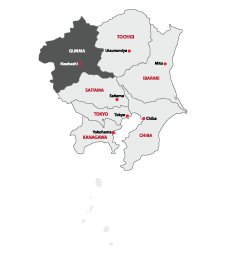 Home to more than 100 hot springs towns, Gunma is a paradise for those that enjoy taking to the waters. Kusatsu Onsen and Ikaho Onsen are the best-known hot springs resorts in Gunma. The thermals at Kusatsu Onsen are so warm that a tradition of female hotsprings attendants singing and ‘paddling’ the waters to cool down their temperatures has become a feature of the onsen. In the town itself, an open-air system also cools the water to bathing level. Ikaho Onsen clings to the side of Mt. Haruna and features two differing waters – ‘gold’ and ‘silver’ differentiated by the minerals that run through them. In between baths, visitors while away their time browsing the shops that line the stairs climbing through the town, and enjoy the town’s signature steamed buns – a sweet treat created by harnessing the power of the onsen. In the Minakami Onsen area, there are smaller onsen areas that are destinations in and of themselves such as Hoshi Onsen and Takaragawa onsen. The former is atmospheric for its traditional wooden buildings and bath, and the latter for its position along the river that gives it its name, with outside baths. Shima onsen also has a long history and is known for the reputed healing benefits of its waters. Sekizen Ryokan, located at Shima Onsen, is the oldest ryokan in Japan and is said to be the inspiration for the ryokan in Hayao Miyazaki’s movie, Spirited Away.
Home to more than 100 hot springs towns, Gunma is a paradise for those that enjoy taking to the waters. Kusatsu Onsen and Ikaho Onsen are the best-known hot springs resorts in Gunma. The thermals at Kusatsu Onsen are so warm that a tradition of female hotsprings attendants singing and ‘paddling’ the waters to cool down their temperatures has become a feature of the onsen. In the town itself, an open-air system also cools the water to bathing level. Ikaho Onsen clings to the side of Mt. Haruna and features two differing waters – ‘gold’ and ‘silver’ differentiated by the minerals that run through them. In between baths, visitors while away their time browsing the shops that line the stairs climbing through the town, and enjoy the town’s signature steamed buns – a sweet treat created by harnessing the power of the onsen. In the Minakami Onsen area, there are smaller onsen areas that are destinations in and of themselves such as Hoshi Onsen and Takaragawa onsen. The former is atmospheric for its traditional wooden buildings and bath, and the latter for its position along the river that gives it its name, with outside baths. Shima onsen also has a long history and is known for the reputed healing benefits of its waters. Sekizen Ryokan, located at Shima Onsen, is the oldest ryokan in Japan and is said to be the inspiration for the ryokan in Hayao Miyazaki’s movie, Spirited Away.
While hot springs are a highlight of Gunma prefecture, they are just one of the many highlights of the area. Natural beauty also abounds in its peaks and rivers, with opportunities in the area to ski and snowboard in the winter in the areas surrounding Minakami. In ‘green season’ adventurists enjoy rafting and canyoning along the Tone River in the Minakami area and mountain biking. The Oze National Park offers marshland hiking at Ozegawara and lake walking at Ozenuma. From Tone, a cable car operates up Mt Tanigawa, which lies on the borders of both Niigata and Gunma Prefectures. The views from the top are breathtaking. In the Maebashi area, Mt. Akagi offers Lake Onuma, a crater lake.
Gunma is the home of the Daruma – a round charm created without pupils in its eyes. Fill in one pupil while making a wish, and once the wish comes true, fill in the second pupil. Shorinzan Darumaji Temple is dedicated to Daruma. Byakue Kannon station, 42m tall, takes prominence in the skyline above Takasaki. Takasaki is also the gateway not just to Mt. Akagi and Mt.Myogi, but also Mt Haruna, and the millennium-old Haruna Shrine. Near Takasaki is the Tomioka Silk Mill, a UNESCO World Heritage site of industrial significance in what was once a key sericulture area.



Saitama Prefecture
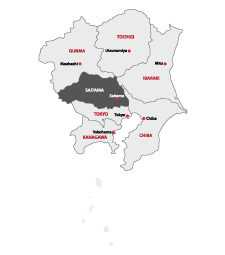 Saitama, nestled just north of Tokyo, lies within the capital’s commuter belt. The prefecture offers attractions of its own. For those with an interest in Japan’s trains, Omiya’s Railway Museum is home to an impressive collection of rolling stock – from Japan’s first train to its bullet trains. If mastery of the rails interests you less than the mastery of nature, then pay a visit to the ‘Bonsai village’ – a neighbourhood of nurseries where Bonsai artists create artfully groomed miniature trees that seem to belong to a fairyland. Also in the Omiya area in East – Central Saitama is Hikawa Shrine. The area has been a sacred site and there has been a shrine in these sprawling natural surroundings for 2400 years. Susanoo, the deity associated with the sea and storms, is enshrined here. For a taste of more recent history, Okegawa, a former post town of the Nakasendo Trail, retains traces of its Edo period history in its architecture and preserved buildings.
Saitama, nestled just north of Tokyo, lies within the capital’s commuter belt. The prefecture offers attractions of its own. For those with an interest in Japan’s trains, Omiya’s Railway Museum is home to an impressive collection of rolling stock – from Japan’s first train to its bullet trains. If mastery of the rails interests you less than the mastery of nature, then pay a visit to the ‘Bonsai village’ – a neighbourhood of nurseries where Bonsai artists create artfully groomed miniature trees that seem to belong to a fairyland. Also in the Omiya area in East – Central Saitama is Hikawa Shrine. The area has been a sacred site and there has been a shrine in these sprawling natural surroundings for 2400 years. Susanoo, the deity associated with the sea and storms, is enshrined here. For a taste of more recent history, Okegawa, a former post town of the Nakasendo Trail, retains traces of its Edo period history in its architecture and preserved buildings.
For a step into the Edo period past, however, the Western Saitama town of Kawagoe delivers in many respects. The town is a popular day trip destination from Tokyo. The historic Koedo contains preserved thick-walled storehouses, designed to protect merchants’ wares from the threat of fire. Today, the storehouses, or kura, contain shops and eating establishments. A wooden bell tower, still in use today, rings the time at 4 points during the day. Also a short jaunt from Tokyo lies Tokorozawa, where you’ll find the Sayama Hills forested area, which inspired Hayao Miyazaki visuals in My Neighbour Totoro. For those with an interest in Japan’s aviation, rather than its trains, a comprehensive museum can be found in Tokorozawa also.
In the Nagatoro and Chichibu areas, you’ll find natural getaways from Tokyo’s urban sprawl. The Nagatoro area offers enjoyments along the Arakawa river, whether that is boat journeys through the gorge, whitewater rafting, or enjoying the beautiful river views. In the autumn, travel up the cable car for views of the autumn foliage over the river. The nearby Nakatsu valley also has a reputation for offering beautiful autumn views of the rich scarlets and golds of the changing leaves. In springtime, the gentle slopes of Hitsujiyama Park are covered with various shades of delicate pink moss phlox, providing colorful vistas. For spiritual-oriented hiking, there is also a 34 temple pilgrimage route in the area dating back to the 14th century. In winter, Chichibu lights up with the local nighttime Chichibu Yomatsuri, which lights up the sky with lantern bedecked floats and fireworks. The Kumagaya area, nestled between the Arakawa river and the Tone river, also offers great cherry blossom viewing and the ancient burial mounds of Gyoda.



Kanagawa Prefecture
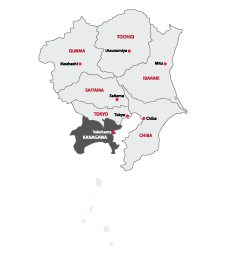 Last but certainly not least in the Kanto area is Kanagawa prefecture. Kanagawa lies southwest of Tokyo, along Japan’s coastline. Yokohama, Japan’s preeminent port city, is Japan’s 2nd largest city and many people live in the Yokohama and Kawasaki areas and commute to Tokyo from here. Yokohama’s attractions for visitors include a developed port district with old red-brick warehouses converted into retail complexes, as well as a series of amusements and entertainments for visitors such as zoos, amusement parks, and Ferris wheels. The Yokohama instant ramen museum provides insights into the growth of a convenience food that has taken the world by storm and sustained millions with quick and budget-friendly sustenance. You can also sample various kinds of freshly made ramen at the Shin Yokohama Ramen Museum, which features regional ramen variations from all over the country. As a port city, Yokohama has acted as an entry point to Japan from other Asian countries, and Yokohama’s Chinatown is one of the world’s largest and most vibrant. The Motomachi and Yamate areas of Yokohama also bear traces of foreign communities that settled in this port city, one of the early areas to open up to foreign trade settlements. Western-style buildings dating from the 1920s and 1930s give a taste of Yokohama in its heyday. For a taste of Japan in the city, Sankeien garden is a traditional Japanese strolling garden, made distinctive by the 17 buildings in the grounds relocated here from all over Japan.
Last but certainly not least in the Kanto area is Kanagawa prefecture. Kanagawa lies southwest of Tokyo, along Japan’s coastline. Yokohama, Japan’s preeminent port city, is Japan’s 2nd largest city and many people live in the Yokohama and Kawasaki areas and commute to Tokyo from here. Yokohama’s attractions for visitors include a developed port district with old red-brick warehouses converted into retail complexes, as well as a series of amusements and entertainments for visitors such as zoos, amusement parks, and Ferris wheels. The Yokohama instant ramen museum provides insights into the growth of a convenience food that has taken the world by storm and sustained millions with quick and budget-friendly sustenance. You can also sample various kinds of freshly made ramen at the Shin Yokohama Ramen Museum, which features regional ramen variations from all over the country. As a port city, Yokohama has acted as an entry point to Japan from other Asian countries, and Yokohama’s Chinatown is one of the world’s largest and most vibrant. The Motomachi and Yamate areas of Yokohama also bear traces of foreign communities that settled in this port city, one of the early areas to open up to foreign trade settlements. Western-style buildings dating from the 1920s and 1930s give a taste of Yokohama in its heyday. For a taste of Japan in the city, Sankeien garden is a traditional Japanese strolling garden, made distinctive by the 17 buildings in the grounds relocated here from all over Japan.
Kawasaki lies between Tokyo and Yokohama. This commuting belt town is home to Daishi temple, the headquarters of the Chinzan sect of Shingon Buddhism. Its Nihon Minka-en open-air museum collects a variety of Japanese architectural forms, with a large selection of Edo period buildings. Also in Kawasaki is the ‘Doraemon’ museum, known formally as the Fujiko F Fujio Museum. This museum, dedicated to the artist and creator of Doraemon, offers much for fans of this very popular blue character, a time-traveling robotic cat.
Hakone, in Kanagawa, is one of the major gateways to Fujisan, Japan’s tallest peak and a truly iconic image of Japan. Hakone lies in the Fuji Hakone Izu National Park and is an area rich in forests, smaller peaks, and many natural onsen fed by the volcanic activity in the area. At the gateway to the Hakone area is Odawara, offering the nearest bullet train stop. Odawara Castle, with its white-walled defenses, was built in the 1400s and rebuilt in later centuries. From Odawara, it is possible to travel onward by various modes of transportation into the Hakone area. Hakone Yumoto is a transportation hub into the area. Here there are numerous ryokan with traditional onsen. Traveling through the area involves navigating many forms of transport – from private rail lines to funicular, to ropeways and gondolas. At Owakudani, conditions permitting, it is possible to walk among the steaming fumaroles and dine on eggs boiled in the onsen water which are turned black by the sulfurous waters. From Togendai, boat cruises travel across Lake Ashi. On a clear day, the peak of Fujisan emerges from behind surrounding lower peaks.
Moto Hakone was the site of a major checkpoint on the Tokaido route between Tokyo and the domains to the west to control the movement of people and a museum recreates the checkpoint. A restored portion of the route, including the sugi-namiki, a section of the Tokaido lined with towering cedars, and trails with restored ishidatami, or paving stones, provide a feel for the old route, complete with a traditional tea house that sustained travelers on their way. Yosegi, the craft of using different colored woods to create delicately ornate parquetry works, is a local craft that can be found not just in souvenir shops, but in craft studios in the Hatajuku area.
The Gora area near Hakone provides a stunning backdrop to an interesting array of art museums. The Hakone Open-Air Museum is home to sculptural works from domestic and international artists. In the immediate area, the Pola Art Museum, the Hakone Art Museum, and the Okada Museum of Art are all relatively near to Gora.
Kamakura was the political center of Japan in the 12th-century reign of the Minamoto clan. The most notable sights remaining consist mostly of historic temples and shrines. The start sights of Kamakura are Kotoku-in temple, with its large Amida Buddha statue. The Tsurugaoka Hachimangu shrine is found in the heart of the town and was central to the Minomoto rule in the town. The shrine sits in a dominating position on a hillside at the end of a long approach lined with shops, the shrine is surrounded by lotus ponds and gardens. Nearby Hasedera becomes a riot of colour in the early summer months as the many hydrangea bushes on the surrounding hillside blossom in rich white, blue, purple, and pink blooms. These temples and shrines are but a few highlights of this beautiful area. Kenchoji temple marks one end of the Ten’en hiking trail in the area, Hokoku-ji temple is known for its stands of bamboo, and Tokei-ji temple once acted as a sanctuary for women. One could easily spend a few days wandering between the historic shrines and temples, many of which are rooted in the Zen tradition.



